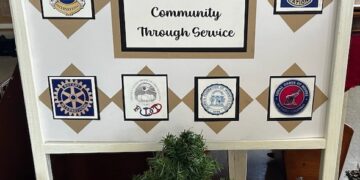
As an FFA member, that contest was always my favorite and years later when I became an FFA Advisor, it remained my favorite team to coach. I got to teach forestry units in the classroom and train teams after school that competed and won contests on the federation, area, and state levels.
While teaching about trees, I’ve also collected information and photographs of many unique specimens. I’ve been privileged to see the giant sequoias in California and enormous banyan and monkey pod trees in Hawaii. I also got to take some students to see and measure the largest known oak in Shenandoah County.
With this type of interest, imagine how my radar went crazy when someone told me there was a tree at Fisher’s Hill that had been used by Confederate lookouts in the Civil War battle. I was initially a bit skeptical that such a tree had survived and somewhat doubted the story since many similar false legends persist.
Imagine my joy and excitement when I did visit the site and discovered the monster still stood! The majestic Chestnut Oak, while not as large as a sequoia, nevertheless graced the crest of the hill overlooking the site where a battle was joined involving 40,000 soldiers. All doubt evaporated as I examined this ancient brute with several massive limbs, certain it contained mini balls near where lookouts once perched.
This September marks the 159th anniversary of this battle when Jubal Early’s Confederate troops tried in vain to stop Philip Sheridan’s Union forces from advancing south. Their failure to do so resulted in Sheridan’s brutal burning of Shenandoah Valley barns, mills, and crops.
The Yankees successfully flanked Early’s troops that day by attacking from the northwest along the mountains and pushed the Rebels south and east. Early thought his west flank was secure and believed his outnumbered army could still be victorious. I’m sure if he had it to do over, he would have concentrated many more troops along that western flank and kept the valley from subsequent destruction.
Unfortunately Early had no second chance and some instances in our lives are similar. Many times, however, we have numerous chances for course correction and even reversal. We must recognize these opportunities and use them wisely.
Although we only get one shot at raising our children, we are given fresh chances every morning to do better than the day before. Although we only have one go around at our jobs, daily decisions can be altered to improve going forward.
Where we have been unkind to another, today is an opportunity to apologize and be more like Jesus. I’m sure Early and his troops used the painful lessons learned that day to do things differently in future battles.
God is very compassionate and longsuffering. Each new day He grants is another opportunity to get it right. Where we left some good deed undone, today provides the chance to do it.
During my teaching career, one of my co-workers had a great response to my question of, “How are you doing today?” He would answer, “Just another chance to get it right.” That’s a great way to welcome life every single morning. We’ve all messed up in our pasts but we have the rest of today as well as however many tomorrows we get to make fresh starts.
As we remember the big tree at Fisher’s Hill and the mistakes and triumphs made on both sides of the line 159 years ago this month, let’s examine our own lives in prayerful reflection to gain whatever wisdom God may grant for our lives going forward. Blessings, George
































